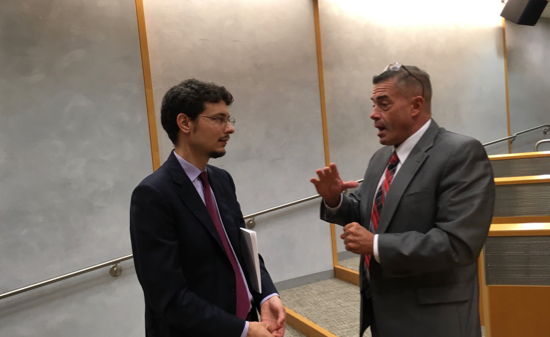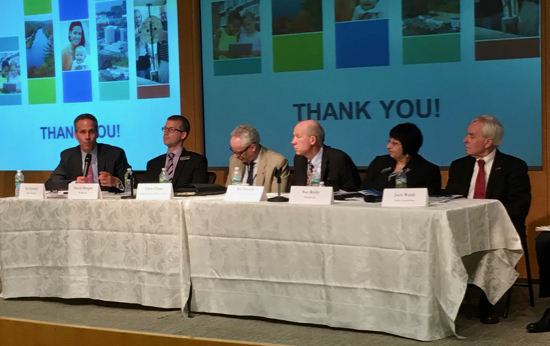 What can be done to retain Derby families who are struggling to stay in the city?
What can be done to retain Derby families who are struggling to stay in the city?
Why are the asthma rates so high in Ansonia and Derby?
By the year 2025, the Valley’s senior citizen population is expected to have grown by 102 percent since 1990. But will those seniors be able to live in their homes? Will there be a support system to help them? What will they need?
Those were just some of the questions pondered in Shelton last month during the unveiling of the 2016 Valley Community Index, a comprehensive report outlining the challenges facing the lower Naugatuck Valley.
Click here to download the report from the Valley Community Foundation.
The report, which was unveiled during a forum at Scinto Auditorium (3 Corporate Drive) in Shelton, is a call to action for Valley leaders — or at least a blueprint for one.
Similar studies in the past showed breast cancer rates in the Valley were higher than the norm, and the conversations over that subject led to the The Hewitt Center for Breast Wellness at Griffin Hospital in Derby, which opened in 2011.
At the end of last month’s forum, many people in the audience — school superintendents, nonprofit leaders, state and local elected officials — stuck around after the event was over. They were talking about forming subgroups to attack the issues raised in the report.
The forum featured a speaker panel. Each panelist took a specific nugget of data from the index and expanded upon it.
“We didn’t ask the panelists to tell us about the good news,” Sharon Closius, president and CEO of the Valley Community Foundation, said. “Everybody knows about the good news in the Valley — about how beautiful it is, and the quality of life. But we asked them to talk about issues you may not know about.”
The panelists included:
- Patrick Charmel, the president and CEO of Griffin Hospital in Derby.
- Christopher Clouet, the superintendent of the Shelton school district.
- David Morgan, the president and CEO at TEAM, Inc. in Derby.
- Bill Purcell, the president of the Greater Valley Chamber of Commerce.
- Suzanne Reilly, TEAM Inc.‘s director of family support services.
- Jack Walsh, the recently retired president of the Valley United Way.
Charmel said the community index points out significant disparities in the wellbeing of Valley residents.
For example, in Derby and Ansonia, emergency room visits for asthma hovers around 12 visits per 1,000 people. In Shelton, the rate is about 3 visits per 1,000 people.
The hospital is already taking steps to address the issue.
“What is leading to this?” Charmel asked. “Access to care and medication to manage that asthma? Is it the environment? We have to look at the quality of housing. Is there something going on in the environment, in someone’s home that is leading to these acute exacerbations? Is it general wellbeing? Things like nutrition and physical activity?”
Charmel noted simply spending money on healthcare may not be the answer. Perhaps that money would be better spent on social services, with professionals who could address larger issues at their roots.

“We know there are a series of underlying issues, and were are going to have to address them,” Charmel said. “It’s not just medical care delivery. There is an area in between — the social determinants of health. That’s where we need to focus.”
Charmel’s statement emerged as a theme during the forum.
The solution to any “challenge” highlighted in the report wasn’t one group’s responsibility. Solutions are community efforts.
Morgan touched upon the high price of childcare, and how quickly it eats up a family’s budget.
Ideally childcare shouldn’t exceed 7 percent of a family’s income. The community index report shows childcare taking up about 11 to 15 percent of local family budgets.
For low-income families in the Valley, up to 40 percent of income goes toward childcare.
“Think about the challenges that come along with that,” Morgan said. “The lack of choice and opportunities. I haven’t begun to talk about housing — about putting food on the table. Transportation. Health care. Taxes.”
Morgan also pointed out one in three families in the Valley struggle to pay for diapers.
Suzanne Reilly talked about the Valley’s growing senior population. The number of senior citizens in the Valley will only grow larger as baby boomers age.
And, according to the community index report, those seniors want to “age in place.”
But houses in the Valley are old. They were not built with senior citizens in mind. They’re not accessible to wheelchairs. The hallways aren’t wide enough. The doorknobs aren’t made for people with arthritis.
These are issues that will have to be dealt with as the Valley’s population ages.
As it stands, transportation for the Valley’s senior population is already an issue.
More than 50 percent of the senior citizens helped by TEAM live alone, Reilly said. They need help getting to the bank, to the doctor’s office.
“We get calls everyday from individuals who need a ride,” Reilly said.
More than 50 percent of the seniors helped by TEAM are older than 80 — and that segment of “super seniors” is projected to increase.
“There are many seniors taking care of other seniors,” Reilly said. “And that presents many challenges.”
“There’s no adult daycare in the Valley,” she said. “Individuals are traveling to Stratford and Hamden and Middlebury every day to get much-needed care.”
Valley lawmakers and social service agencies are taking steps to help the burgeoning senior population. Plans are underway for a Valley senior citizen “daycare” in Seymour, at the community center on Pine Street.
The panelists took questions and comments from the audience, too.
Education in the Valley was a trending topic.
The community index report pointed out that a large percentage of people move in and out of Derby every year.
Matthew Conway, the superintendent of the Derby school system, said the influx and outpouring of students poses significant issues.
About 100 students have come and gone since August at Derby High School and one of the district’s elementary schools.
But the student population has remained the same, because 100 new kids moved to Derby.
“These are the very students we probably spend more per pupil expenditure on than any other student … and they are somewhere else starting from scratch.”
The issue is housing, Conway said.
The underlying issue could be how the government spends on federally subsidized housing.
“When you look at those students who are in most need, they are the same students we talk about that are in need of housing. They are the same students that we are talking about when we say we have a very transient population,” Conway said.
Housing and education can’t be viewed as separate issues, the superintendent said.
“We’re misspending housing and we’re misspending education. We need to bring the two to the table and look at stabilizing our mobile population.”
The community index covers Ansonia, Beacon Falls, Derby, Naugatuck, Oxford, Seymour and Shelton.
DataHaven was the lead author of the index. Lead sponsors included the Bassett Family Fund, Griffin Health Services, Inc., Katharine Matthies Foundation, Bank of America, N.A., Trustee; and the Valley United Way.
For more information, visit the Valley Community Foundation’s website.